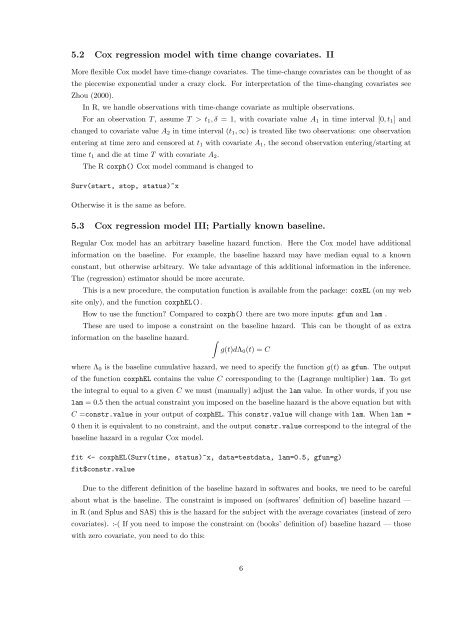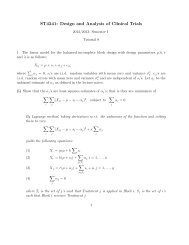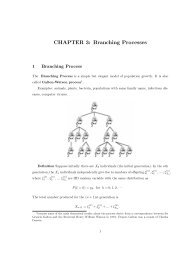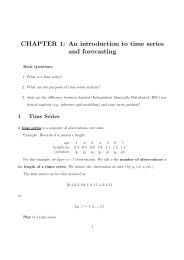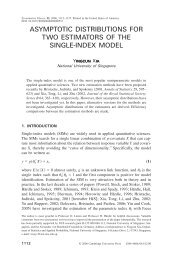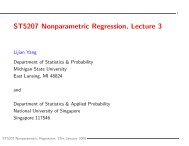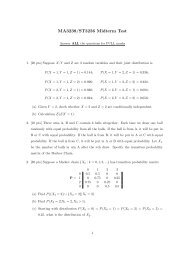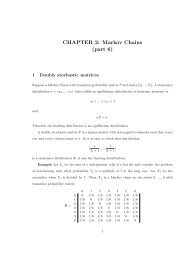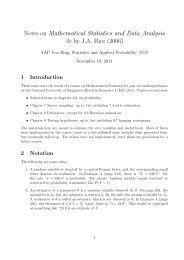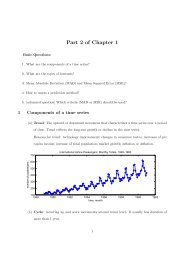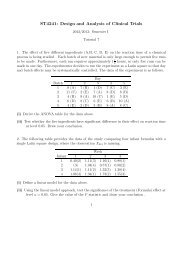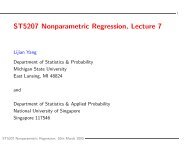Use Software R to do Survival Analysis and - The Department of ...
Use Software R to do Survival Analysis and - The Department of ...
Use Software R to do Survival Analysis and - The Department of ...
You also want an ePaper? Increase the reach of your titles
YUMPU automatically turns print PDFs into web optimized ePapers that Google loves.
5.2 Cox regression model with time change covariates. II<br />
More flexible Cox model have time-change covariates. <strong>The</strong> time-change covariates can be thought <strong>of</strong> as<br />
the piecewise exponential under a crazy clock. For interpretation <strong>of</strong> the time-changing covariates see<br />
Zhou (2000).<br />
In R, we h<strong>and</strong>le observations with time-change covariate as multiple observations.<br />
For an observation T , assume T > t 1 , δ = 1, with covariate value A 1 in time interval [0, t 1 ] <strong>and</strong><br />
changed <strong>to</strong> covariate value A 2 in time interval (t 1 , ∞) is treated like two observations: one observation<br />
entering at time zero <strong>and</strong> censored at t 1 with covariate A 1 , the second observation entering/starting at<br />
time t 1 <strong>and</strong> die at time T with covariate A 2 .<br />
<strong>The</strong> R coxph() Cox model comm<strong>and</strong> is changed <strong>to</strong><br />
Surv(start, s<strong>to</strong>p, status)~x<br />
Otherwise it is the same as before.<br />
5.3 Cox regression model III; Partially known baseline.<br />
Regular Cox model has an arbitrary baseline hazard function. Here the Cox model have additional<br />
information on the baseline. For example, the baseline hazard may have median equal <strong>to</strong> a known<br />
constant, but otherwise arbitrary. We take advantage <strong>of</strong> this additional information in the inference.<br />
<strong>The</strong> (regression) estima<strong>to</strong>r should be more accurate.<br />
This is a new procedure, the computation function is available from the package: coxEL (on my web<br />
site only), <strong>and</strong> the function coxphEL().<br />
How <strong>to</strong> use the function? Compared <strong>to</strong> coxph() there are two more inputs: gfun <strong>and</strong> lam .<br />
<strong>The</strong>se are used <strong>to</strong> impose a constraint on the baseline hazard. This can be thought <strong>of</strong> as extra<br />
information on the baseline hazard. ∫<br />
g(t)dΛ 0 (t) = C<br />
where Λ 0 is the baseline cumulative hazard, we need <strong>to</strong> specify the function g(t) as gfun. <strong>The</strong> output<br />
<strong>of</strong> the function coxphEL contains the value C corresponding <strong>to</strong> the (Lagrange multiplier) lam. To get<br />
the integral <strong>to</strong> equal <strong>to</strong> a given C we must (manually) adjust the lam value. In other words, if you use<br />
lam = 0.5 then the actual constraint you imposed on the baseline hazard is the above equation but with<br />
C =constr.value in your output <strong>of</strong> coxphEL. This constr.value will change with lam. When lam =<br />
0 then it is equivalent <strong>to</strong> no constraint, <strong>and</strong> the output constr.value correspond <strong>to</strong> the integral <strong>of</strong> the<br />
baseline hazard in a regular Cox model.<br />
fit


